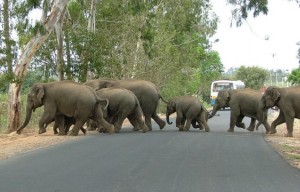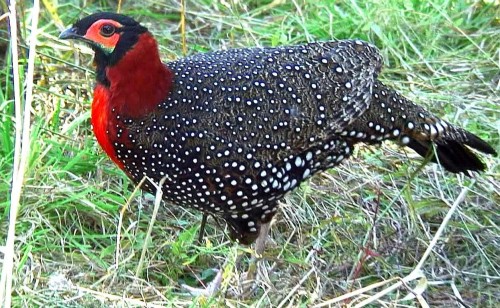 Africa is home to almost 3.5 lakh elephants and 80 percent of wild elephants of the nation live outside protected areas. Yet the recorded cases of man-animal conflict are very low. Comparatively the state of Karnataka has just 6000 wild elephants which are increasingly being killed due to human-animal conflicts. It is to find answers to this growing problem that state forest officials travelled to Africa to know what the nations there are doing right to prevent loss of animal life.
Africa is home to almost 3.5 lakh elephants and 80 percent of wild elephants of the nation live outside protected areas. Yet the recorded cases of man-animal conflict are very low. Comparatively the state of Karnataka has just 6000 wild elephants which are increasingly being killed due to human-animal conflicts. It is to find answers to this growing problem that state forest officials travelled to Africa to know what the nations there are doing right to prevent loss of animal life.
Forest officials from Karnataka recently visited the parks of Kenya and Tanzania to get firsthand knowledge of the way the elephants of Africa are treated by the locals that helps humans and animals live in peace.
“They are managed by the local community who understand their behaviour. We will now scale up our efforts to involve the local community to conserve wildlife. Awareness has to be brought about and people need to be sensitised about the importance of wildlife and its conservation,” B K Singh, principal chief conservator of forests (wildlife), Karnataka said.
In Karnataka 29 animal deaths due to man animal conflict was recorded in 2010-11, 33 in 2009-10 and 40 in 2008-09. A majority of these involved elephants.
The approximate 6000 number of wild elephants in Karnataka are mostly scattered around eight-lakh-hectares of elephant reserves in the districts of Chamarajanagar, Mysore, Hassan, Kodagu and Ramanagaram, all under the Mysore elephant reserve. In comparison in Kenya and Tanzania alone 60,000 wild elephants are found with most living outside protected areas.
The officials said that the most important lesson learnt is to respect the time when elephants move about in their corridors which is usually early mornings or late nights. In the state currently many humans are trampled under the elephants because they venture out in the wrong time when elephants are also out looking for food. The humans then are considered an intrusion by the animal resulting in its angered behaviour.
The agriculture ministry too recently tried to analyse the problem behind the increased elephant conflicts in the state and has suggested farmers to not plant any food crops that attract wild herds.
“The recommendations include persuading the farmers to grow crop that would not attract elephants, a shift from commercial to flower and tree crops. Also, leaving some land fallow on the habitat fringes so that elephants who come in search of food can eat the available grass and go back to the forest without causing any harm,” said M H Swaminath, assistant principal chief conservator of forest (wildlife), Karnataka.
To ape the African model, noted naturlist Ullas Karanth feels the practical aspect of the options available have to be studied and applied.
“We need to consider the practicality of applying the African model here. There are three clear options. First, if the area in which villagers are living happens to be a prime wildlife habitat, people must be moved out of the place and relocated after being given an alternative source of income. Secondly, if the elephants are present only in fragmented areas, then they need to be gathered and relocated to a suitable place where they can be in a herd. Finally, wildlife habitat needs to be clearly demarcated from the areas where local people live by putting in place barbed wires, electric fences etc,” said Ullas Karanth.
The challenges laid out for Karnataka are immense as the new ideas lead to new problems. Will farmers be willing to adopt new farming practices and plant different crops? Will villagers willingly relocate and leave elephant corridors? Will it be possible to gather wild herds and put them under constant surveillance so that any elephant activity can be noted?
It is certainly a step towards a more prudent approach to solving the man- animal conflict in the state, but whether Africa’s success story can be repeated in Karnataka, that needs to be seen.
Related Stories:
Temple Elephants Head for a Rejuvenation Camp
Scientists Develop Model to Predict Human-Animal Conflict Zones
Interesting Facts About the Indian Elephant
Reference: TOI






2 thoughts on “Karnataka Learns Lessons from Africa to minimise Man-elephant Conflict”